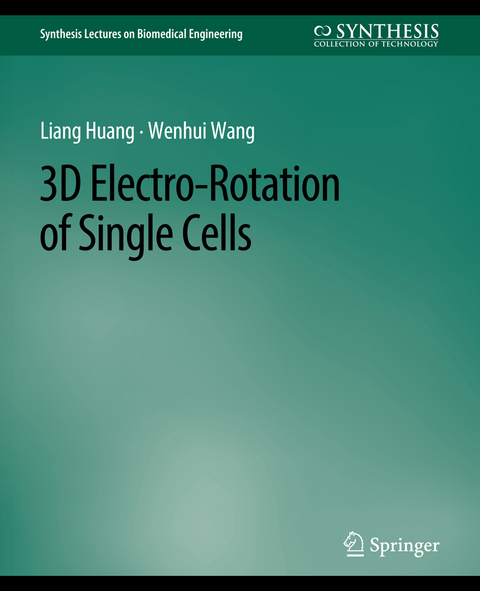
3D Electro-Rotation of Single Cells
Springer International Publishing (Verlag)
978-3-031-00538-1 (ISBN)
Dielectrophoresis microfluidic chips have been widely used in various biological applications due to their advantages of convenient operation, high throughput, and low cost.
However, most of the DEP microfluidic chips are based on 2D planar electrodes which have some limitations, such as electric field attenuation, small effective working regions, and weak DEP forces. In order to overcome the limitations of 2D planar electrodes, two kinds of thick-electrode DEP chips were designed to realize manipulation and multi-parameter measurement of single cells.
Based on the multi-electrode structure of thick-electrode DEP, a single-cell 3D electro-rotation chip of "Armillary Sphere" was designed. The chip uses four thick electrodes and a bottom planar electrode to form an electric field chamber, which can control 3D rotation of single cells under different electric signal configurations. Electrical property measurement and 3D image reconstruction of single cells are achieved based on single-cell 3D rotation. This work overcomes the limitations of 2D planar electrodes and effectively solves the problem of unstable spatial position of single-cell samples, and provides a new platform for single-cell analysis.
Based on multi-electrode structure of thick-electrode DEP, a microfluidic chip with optoelectronic integration was presented. A dual-fiber optical stretcher embedded in thick electrodes can trap and stretch a single cell while the thick electrodes are used for single-cell rotation. Stretching and rotation manipulation gives the chip the ability to simultaneously measure mechanical and electrical properties of single cells, providing a versatile platform for single-cell analysis, further extending the application of thick-electrode DEP in biological manipulation and analysis.
Liang Huang received a B.E. in 2008 from Tianjin University, an M.E. in 2011 from University of Science and Technology of China, and a Ph.D, in 2019, from Tsinghua University. He is now at the Hefei University of Technology, where his current research interests include BioMEMS and microfluidic devicesWenhui Wang received a B.E. in 1998 and an M.E. in 2001 from Beijing Institute of Technology, and Ph.D. in Mechanical Engineering from National University of Singapore (2005). He received post-doc training at the University of Toronto and then joined the faculty at the University of Canterbury in 2007. In 2012, he relocated to Tsinghua under the Chinese Government Young 1000-Talent Plan. His current research interests include BioMEMS and microfluidic devices and systems, aiming for bio-micro-manipulation and analysis of single cells and model organisms.
Acknowledgments.- Introduction.- Thick-Electrode DEP for Single-Cell 3D Rotation.- Opto-Electronic Integration of Thick-Electrode DEP Microfluidic Chip.- Summary and Outlook.- References.- Authors' Biographies.
| Erscheinungsdatum | 06.06.2022 |
|---|---|
| Reihe/Serie | Synthesis Lectures on Biomedical Engineering |
| Zusatzinfo | XVII, 101 p. |
| Verlagsort | Cham |
| Sprache | englisch |
| Maße | 191 x 235 mm |
| Gewicht | 243 g |
| Themenwelt | Medizin / Pharmazie ► Physiotherapie / Ergotherapie ► Orthopädie |
| Naturwissenschaften ► Physik / Astronomie ► Angewandte Physik | |
| Technik ► Medizintechnik | |
| ISBN-10 | 3-031-00538-4 / 3031005384 |
| ISBN-13 | 978-3-031-00538-1 / 9783031005381 |
| Zustand | Neuware |
| Haben Sie eine Frage zum Produkt? |
aus dem Bereich


